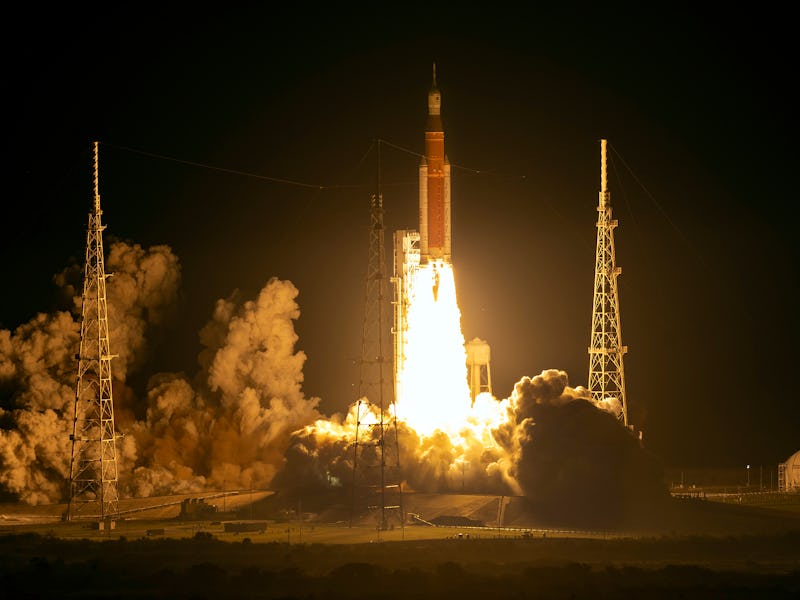Artemis I is on the way to the Moon — what’s next?
Launch is only the beginning.

Artemis I blasted off into space late Tuesday night atop a plume of rocket fire, and as of Wednesday morning, the mission is on its way to the Moon (and back).
The Artemis I launch was the long-awaited culmination of years of effort and a series of delays, but getting the rocket off the ground marks only the beginning of the 26-day mission. Over the next few weeks, the Artemis I mission will test the capabilities of the Orion crew capsule in deep space and on the return to Earth. Here’s what to expect over the next few days as Artemis I flies to the Moon, makes its giant retrograde orbit, and finds its way home.
What is Artemis I doing right now?
As of the morning of November 16, the Orion spacecraft is coasting through space at about 20,000 miles per hour on its way to the Moon. It will take another four days to get there, with a few small nudges from the spacecraft’s engines to ensure it’s on the right course.
Along the way, Orion will release 10 shoebox-sized CubeSats to study Earth, the Moon, and the environment of deep space. One, called OMOTENASHI, will actually land on the lunar surface; its goal is to test systems for very small landers, which might be used later on the Moon and elsewhere in our Solar System.
Another CubeSat, called BioSentinel, carries colonies of yeast, which scientists will study over the next year to see how they grow and evolve in deep space. This is the first long-term biology experiment beyond low Earth orbit, where Earth’s magnetic field offers some protection from the harsh radiation of deep space. Understanding how living things respond when exposed to that radiation over time will be an important part of designing future missions to the Moon and Mars.
What’s the next big milestone for Artemis I?
Orion will whiz past the Moon, just 60 miles above the rocky lunar surface, on the morning of November 21 in a maneuver called the Outbound Powered Fly-by. This close encounter with the Moon and its gravity will help set the spacecraft up to enter the wide, backward orbit that will carry it around the Moon and back.
The Outbound Powered Fly-by was originally scheduled for 7:44 a.m. Eastern on November 21, but that was before a roughly 40-minute delay during launch; Inverse will keep you posted, and this story updated, when NASA updates the flight schedule.
A few days later, on November 25, the Orion spacecraft will fire its engines for what’s called an insertion burn: a change in the spacecraft’s speed that lets the Moon’s gravity catch it and pull it into lunar orbit. Orion will make a wide loop around the Moon, following something called a Distant Retrograde Orbit. In other words, it’s going to fly in a wide arc about 38,000 miles beyond the Moon (hence “distant”), traveling opposite the direction in which the Moon rotates (hence “retrograde”).
On the morning of November 26, Orion will officially break Apollo 13’s record for the furthest any spacecraft meant to carry humans has ever traveled from Earth. And two days later, on the evening of November 28, the capsule will reach its maximum distance from home: 298,565 miles away from Earth, on the far side of the Moon.
When will Artemis I return to Earth?
The Orion spacecraft will fire its engines to escape lunar orbit on the evening of December 1 and begin its long cruise home. On the afternoon of December 11, the capsule will splash down in the Pacific Ocean off the coast of California, within sight of a U.S. Navy recovery ship.
This will be the crucial moment for the mission. A key goal for Artemis I is making sure the Orion spacecraft’s heat shields are up to the job of keeping future crews safe from the intense heat of re-entering Earth’s atmosphere: about 5,000 degrees Fahrenheit, according to manufacturer Lockheed-Martin. That’s almost — but not quite — twice as hot as the temperatures faced by a crew capsule returning from the International Space Station, because spacecraft returning from low-Earth orbit are traveling at lower speeds than a spacecraft returning from the Moon, so they experience less friction.
How to follow along with Artemis I
You can track the mission’s progress on NASA’s Artemis Real-time Orbit Website, or AROW. The site will show you where Orion is in relation to Earth and the Moon, as well as how fast it’s moving and in which direction it’s pointed. The spacecraft also has its own Twitter account.
This article was originally published on